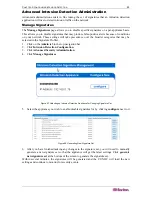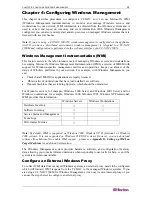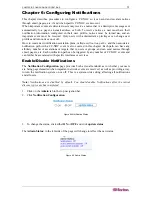
60
COMMANDCENTER NOC ADMINISTRATOR GUIDE
Note: After windows discovery process is complete, you may notice an overlap in devices that
were specified in the Discovery Range – please see Edit Discovery Ranges in Chapter 2:
General and Advanced Administration for additional information. Therefore, it may be
necessary to change the licenses of some devices, especially if you want to collect additional data.
For example, you may want to change a workstation license to a server license if a license is
available – please see Manage, Unmanage, Rescan, or Delete Devices in Chapter 2: General
and Advanced Administration for additional information.
Management naming resolution
The CC-NOC uses the TCP/IP ranges initially to find devices. However, to be able to gather
WMI data from a target host, its WINDOWS NAME must be resolvable from the PROXY
SYSTEM. Ensure that the system you choose as a Proxy has the ability to resolve Windows
Names in the range you specify via either NetBIOS, or services like WINS or
lmhosts
file - see
section
Configure WINS
for details. If the Proxy cannot resolve the Windows Name, even if it
can ping the IP address, you will not be able to communicate with that host to gather WMI data.
Proxy Identification and Credentials
Once you have identified
proxies
and
ranges,
the CC-NOC will begin the discovery process in
search of targets for management via WMI. Now you need to configure authentication
information for your target servers and workstations, for example, desktops, laptops, etc.
Figure 74 Specifying proxy authentication credentials
For every domain, workgroup, or trusted domain that is associated with hosts you wish to manage,
you will need to provide authentication information, for example, username and password, which
will be used to log into the systems and pull performance, event log, and/or system inventory
information. If you wish, you may provide this information on the device-level once the device
has been discovered. Note that this is arguably more secure, but considerably more administration
intensive.
The CC-NOC supports authentication via any of these three common mechanisms for
authentication:
•
Domain-based authentication
•
Workgroup-based authentication
•
Trusted Domain-based authentication
Domain-based authentication is the most commonly used form of authentication in Windows
environments. For every domain that is associated with hosts you wish to manage, you will need
to provide authentication information, for example, username and password, which will be used
to log into the systems and pull performance, event log, and/or system inventory information. The
Username and Password will be passed to a server within the domain for authentication. The
target machine must be a member of this domain and the Username must be configured as a user
within that domain.
Workgroup-based authentication means that the machine has been identified as part of a
Workgroup and that the Username is an existing local user on that particular end system. If you
wish to use local authentication to your target servers/workstations and those machines are not
part of a common workgroup, you will be allowed to enter those local credentials on a subsequent
page. As a part of its systems discovery, the CC-NOC identifies target machines as members of a
Workgroup, if applicable. For those machines, you may specify a local user on those machines to
use for authentication purposes.
Summary of Contents for COMMANDCENTER NOC
Page 2: ...This page intentionally left blank...
Page 12: ...xii FIGURES...
Page 20: ...8 COMMANDCENTER NOC ADMINISTRATOR GUIDE...
Page 114: ...102 COMMANDCENTER NOC ADMINISTRATOR GUIDE...
Page 132: ...120 COMMANDCENTER NOC ADMINISTRATOR GUIDE...
Page 144: ...132 COMMANDCENTER NOC ADMINISTRATOR GUIDE...
Page 148: ...136 COMMANDCENTER NOC ADMINISTRATOR GUIDE...
Page 155: ...APPENDIX G NETWORK TRAFFIC OVERHEAD NETWORK MANAGEMENT S NECESSARY EVIL 143 255 80 5301 00...
















































